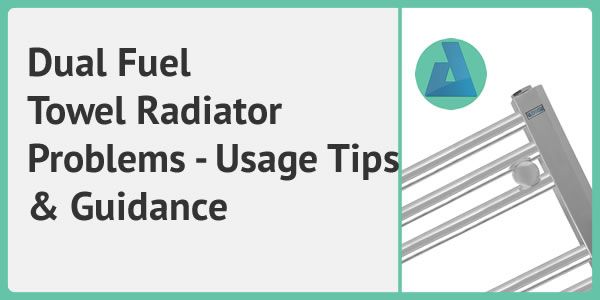To effectively utilize a dual fuel towel radiator, it is essential to first understand the functionality of this type of heating appliance. A dual fuel towel radiator is designed to operate using both the central heating system and electricity. This means that you have the flexibility to use it even when the central heating is turned off in the summer months, making it a versatile option for keeping your towels warm and dry throughout the year.
You can use/convert your central heating towel radiator to a dual fuel one by adding some parts and fittings such as dual fuel corner valves or a T piece, a T pipe (also known as dual fuel adaptor) together with an electric heating element. These additional parts will enable you to use your towel radiator as dual fuel meaning that it can be part of your central heating and can be used as electric only during summer months.
What Is the Correct Way of Using A Dual Fuel Towel Radiator?
Just like any other electrical equipment, installing and using your heating element requires your attention. The first and most important issue is to get it installed by a qualified “and” competent installer. No offense to anyone but not all qualified are competent and not all competent are qualified! So, a little homework to find the right person to do the job is very important to begin with. But once it is installed, how exactly do you mean to use it?
Most people are generally under the impression that they can simply switch from central heating use to electric use without any hassle. Some even believe that both heat sources can be used simultaneously. Unfortunately, this is not the case. The sole purpose of having a dual fuel towel radiator is to be able to have warm towels during summer months only, in which the central heating system is generally turned off. The correct way of using a dual fuel towel radiator would be to use the central heating option during the winter and use the electric option only during the summer.You should also follow the correct procedure when switching from one to the other.
How To Switch From Central Heating To Electric?
Come April or May, you may wish to turn off your central heating and switch your towel radiator from a plumbed radiator to an electric one. Doing so will still kill the chill in your bathroom and let you have warm towels after a bath or shower. By following the steps below, you can protect your central heating, towel radiator, and, most importantly, your electric heating element which is installed inside the towel radiator.
Switch From Central Heating to Electric Element:
- Before you switch from central heating to electric usage, you must isolate the radiator from the rest of your central heating system by turning both inlet (flow) and outlet (return) valves completely off.
- Secondly, you will either need to loosen the bleed valve or the return valve slightly. The trick here is to be very gentle and loosen either of those very slightly. Loosening one of these will reduce the risk of pressure building inside the towel radiator as the electric element heats the trapped water.
- Once the radiator is isolated from the pipe work of your central heating, you can safely turn on your electric heating element allowing it to heat the water inside.
To maximize the efficiency of a dual fuel towel radiator, it is important to set the temperature and timer settings according to your usage patterns. By adjusting the temperature to a comfortable level and setting the timer to turn on and off at specific times, you can ensure that your towels are always warm and ready for use. Additionally, regular maintenance such as cleaning the radiator and checking for any leaks or malfunctions will help prolong the electric element’s lifespan and ensure optimal performance.
Switch From Electric Element to Central Heating:
- Before you switch from electric to central heating, you must turn off your heating element. How you achieve this will depend on the type of electric element you have installed. If it is a simple non-thermostatic heating element or a thermostatic one without a timer program feature, you will simply turn it off from the main fused spur, usually located outside the bathroom. If however, you have a WiFi-enabled thermostatic and programable electric element, you should then set this to holiday mode as turning it off completely from the main spur may erase the program memory.
- Secondly, you will need to tighten back the bleed and turn both the inlet (flow) and the outlet (return) valves to the ON position on your dual fuel corner or angled valves to allow central heating water to circulate through the radiator.
Now let’s look at the consequences of not following the correct procedures described above. Following “ifs” will give you an idea and help you understand those important steps.
- If you do not isolate the radiator by turning the valves to the OFF position, heated water will escape to other parts of the central heating system through valves and pipes work.
- If you do not loosen either the bleed or return valve, the radiator will build pressure and, in some cases, this may lead to a leak, which may even result in a welded joint on the radiator to burst requiring a replacement radiator.
- If the radiator is not isolated, heating element will end up trying to heat the whole central heating system and eventually fail fairly quickly.
- If you turn off a Wifi enabled programable thermostatic element form fused spur, you will loose all the programs.
- If you do not tighten the bleed valve, radiator will suck air as it cools down causing trapper air in your central heating system.
Further Usage Tips & Pre-Install Guidance on Dual Fuel Towel Radiators
It's important to conduct research and planning before installing a dual fuel towel radiator. As well as finding the right person to install it, getting the correct and most appropriate parts will ensure smooth operation throughout the year. Below are some bite-size tips which will help you achieve just that.
- Avoid using a TRV on dual fuel heated towel rails
Unlike standard mechanical valves, thermostatic valves (TRV’s) have either liquid, gas, or wax-filled sensors. It is those sensors that control the water flow. With a standard valve, you can get a complete seal once it is completely shut. However, you may not get a complete seal with TRV’s, and the heated water inside the radiator may escape. - Avoid installing non-thermostatic standard heating elements
Standard elements heat the water to its maximum temperature which can be in the range of 65C to 70C. This may be a little overwhelming, especially in the summer months. After all, you only need the water to be lukewarm to dry your towels and keep them warm but not heat the room. - Avoid room temperature-based thermostatic heating elements
Never use a thermostatic heating element based on “ambiance temperature” (room temperature). As the element should be used in summer months only, your room temperature will likely be over 20 Celsius degrees. Hence a room temperature-controlled thermostatic element may never come on to heat the water inside the radiator. - Choose the correct type of valves
If your pipe work is coming out from the wall, select a dual fuel corner valve that has a built-in T pipe (dual fuel adaptor) as opposed to an angled one. With specially designed dual fuel radiator valves, you will not need to offset the pipe work wider or narrower than the radiator and the whole connection will look neater and symmetrical. - Use two T pipes instead of one
If your pipe work is coming out from the floor, opt in for two T pipes instead of just one. With T pipes on both sides, your installer can adjust the pipe work the same on both sides of the radiator making a more symmetrical setup. See our heated towel rail connection illustrations page to view both one T pipe and two T pipes option to help you visualize how the final setup would like.
In Summary, a dual fuel towel radiator is a versatile heating appliance that can be used with both central heating and electricity by selecting the right parts and valves for installation, allowing you to keep your towels warm and dry throughout the year. But It is important to follow the correct procedures when switching between heat sources to ensure that both the radiator and the element functions properly and to avoid any potential issues.
Updated by Vinnie Ozer // Adige Towel Radiators
18/May/2024 @ 02:16

